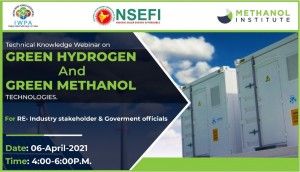From the Methanol Institute, World Wide Web, 2020 – 2021
The “Renewable Methanol: A Carbon-Neutral Fuel” webinar organized by the Methanol Institute took place on August 5, 2020. The webinar is organized with the support of presenting companies Clariant, Haldor Topsoe, bseEngineering, and Ørsted. The global transition towards climate mitigation and greater sustainability has inspired a concerted effort from government, business, and society to find viable solutions to lower greenhouse gas emissions to meet the Paris Climate Agreement.
This transition has led to renewable methanol gaining traction as a carbon-neutral solution for multiple industries. The benefits of renewable methanol are manifold. The production of renewable methanol relies on off-taking CO2 from industrial emitters which allows them to reduce their emissions while moving towards carbon-neutrality. Renewable methanol can then be utilized as a carbon-neutral fuel for multiple applications such as land and marine transport vessels to help them reach their own emission reduction goals.
The webinar shares the experiences of companies that are part of the renewable methanol value chain in various regulatory and commercial landscapes. The companies will also shed light on what they believe is the future of this sustainable solution as global industries move towards limiting their impact on their operating environments and reducing greenhouse gas emissions.
>>>>>>>………………>>>>>>>>………………>>>>>>>>
See also: Technical Knowledge Webinar on Green Hydrogen and Green Methanol, April 6, 2021
Organized by MI, NSEFI and IWPA, this webinar includes plenary sessions on the different facets of producing green hydrogen through green methanol, methanol as a hydrogen carrier and other applications of green methanol followed by Q&A session with industry experts from around the world. The webinar gives a platform to gain insights, learn about solutions and explore potential opportunities for collaboration on clean energy projects in India.


{ 1 comment… read it below or add one }
To: Joseph Kessler, Engineer, West Virginia Department of Environmental Protection’s Division of Air Quality
Dear Mr. Kessler,
The planned Pleasants County West Virginia Methanol facility would endanger the air quality and public health of thousands of Ohio River Valley residents. I urge you to protect our community by denying air permits for this facility.
According to the WV Methanol facility’s permit application, the plant will annually emit 93 tons of nitrous oxide and 92 tons of carbon monoxide, 54 combined tons of three different kinds of particulate matter, and 11 combined tons of the known or probable human carcinogens formaldehyde, acetaldehyde, benzene and 1,3-butadiene. All of these gases are hazardous toxins linked to a host of public health problems. And air quality experts insist that these emissions levels are likely underestimated.
Permitting the facility without any air modeling or environmental impact assessments and with zero consideration of greenhouse gas emissions and non-air quality impacts, including potential impacts on property values, traffic, zoning and national energy issues, places local residents at risk. Because this facility is so close to the major polluter threshold, I ask that WVDEP take every precaution and perform a full review of the WV Methanol facility as a major source of emissions before any permits can be granted.
Moreover, this type of modular facility has never before been built in the United States, meaning that there is absolutely no precedent to evaluate the threats to public health and the environment the plant poses.
This is a step backward for West Virginia. The proposed petrochemical buildout and the attendant “Appalachian Storage Hub” risks the health and safety of West Virginians and should be stopped. This facility should be permitted as a major source, and modeling should be done to gain information about the impact to nearby communities. The current permit application must be denied.
Concerned Ohio River Residents (CORR)
General@concernedohioriverresidents.org
https://www.concernedohioriverresidents.org/